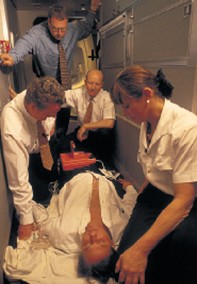Peer Reviewed
Feature Article Occupational health
Medical emergencies on commercial aircraft: prevention and management
Abstract
For most medical practitioners on an aircraft, it is alarming to hear an announcement for a volunteer to give medical assistance to a fellow passenger. The good news is that this situation is infrequent and most times the patient’s condition is not life threatening. Furthermore, equipment and support are available to assist the medical practitioner.
Key Points
- A diligent search has not found an instance of a voluntary doctor being involved in unwelcome litigation related to in-flight assistance.
- Think carefully about patients about to travel by air: should the airline be notified of their special needs?
- Only certain types of electrical equipment may be carried on to planes-depending on electrical supply. Supply on Boeing aircraft is 115 V AC/400 Hz.
- Remember that there are companies which specialise in supplying highly qualified and skilled medical escorts on routine scheduled flights.
- Each medical kit contains a booklet which includes the protocols for using the semi automatic defibrillator. There is a list of and information about available drugs. From April 1, kits are carried on all Qantas domestic as well as international flights.
Purchase the PDF version of this article
Already a subscriber? Login here.

